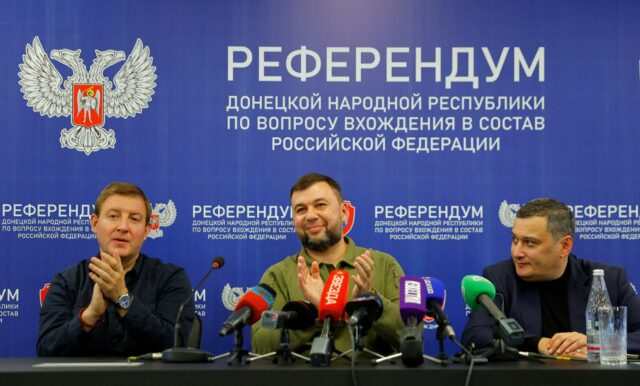
Russia Keeps ‘Gathering’ Non-Russian Lands in Ukraine and Beyond
Publication: Eurasia Daily Monitor Volume: 19 Issue: 145
By:

The Muscovite Tsardom portrayed its relentless territorial expansion as “gathering Russian lands.” In many cases, the lands in question were not even Russian, but once conquered, they were subjected to Russification in due course. The tsars and Russian emperors added the informal but glowing title “gatherer of Russian lands” to their official titles, basking in the adulation of their subjects. These were, on the whole, resigned to servitude in their lives and sacrificial “fraternal graves” on the battlefield in return for a vicarious petty share in Russia’s great-power status. Soviet leader Joseph Stalin and—after the hiatus known as “Russia‘s greatest geopolitical tragedy”—the protagonist of that grievance, Russian President Vladimir Putin, consciously reconnected with Muscovy‘s land-gathering tradition, decidedly in non-Russian lands. Putin’s current land grab in Ukraine, his largest ever, involves Ukrainian-majority populations and territories.
On September 30, at the Kremlin, President Putin and his satraps in Ukraine’s Donetsk, Luhansk, Kherson and Zaporizhzhia regions signed the documents on the incorporation of these occupied territories into Russia (Kremlin.ru, September 30). Mock referendums, improvised on September 23–27 in those territories, precipitated the act of incorporation (see EDM, September 23, 28).
Four territories in one fell swoop represents the grandest of Moscow’s occupations and annexations of neighboring countries’ territories in the post-Soviet era. Overall, the Kremlin just declared the annexation of a whopping 110,000 square kilometers of Ukrainian lands. These are comprised of 27,500 square kilometers in Luhansk region, 26,500 square kilometers in Donetsk region, 28,500 square kilometers in Kherson region and 27,000 square kilometers in Zaporizhzhia region. Russia currently occupies the great bulk of this territorial aggregation and lays official claim to the remainder (see below).
The annexations in mainland Ukraine add to that of the Crimean peninsula in 2014, with a land area of 27,000 square kilometers (including both territorial units: the Autonomous Republic of Crimea and the city of Sevastopol). Including this, Russia has annexed or declared the annexation of a total of 137,000 square kilometers of Ukrainian territory (not counting the Russian-occupied 5 percent of Kharkiv region). Cumulatively, that amounts to 22 percent of Ukraine’s pre-2014 land area totaling 614,000 square kilometers (2001.census.gov.ua, accessed October 2).
The exact number of the populations currently remaining in these territories cannot be known amid the disruptions of occupation and war.
Beyond Ukraine and within the wider Black Sea region, Russia is the occupying power in Moldova’s Transnistria territory (4,100 square kilometers) and in Georgia’s Abkhazia and South Ossetia regions (9,000 and 4,000 square kilometers, respectively). In Transnistria, local Russians form the third-largest element, after Moldovans and Ukrainians. Local Russians in Abkhazia and South Ossetia number in single-digit percentages.
On the ground in Ukraine, as of this writing, Russian forces occupy 90 percent of Luhansk region, 60 percent of Donetsk region, 90 percent of Kherson region and 70 percent of Zaporizhzhia region. Ukraine holds the remainder of each. Under the documents signed on September 30 in Moscow, Russia claims the whole territories of the Donetsk and Luhansk regions within their pre-2014 administrative boundaries, as well as the entirety of the Kherson and Zaporizhzhia regions within their pre–February 24 administrative boundaries (TASS, September 30, October 1, 2).
Ethnic Ukrainians formed the majority of the population in these four regions, cumulatively, as well as in each region, separately, until Russia invaded Donetsk and Luhansk in 2014 and then Kherson and Zaporizhzhia in 2022. The invasions, war and exodus of internally displaced persons and refugees have dramatically reduced the resident population in significant numbers. The last census, conducted in 2001, documented both the size of the ethnic Ukrainian majorities and the linguistic Russification of Ukrainians and others as a legacy of the Russian imperial and Soviet eras (2001.census.gov.ua, accessed October 2).
In Donetsk region, that census recorded 4.8 million people, including 57 percent who self-identified as ethnic Ukrainians and 38 percent who self-identified as ethnic Russians. Conversely, 24 percent indicated Ukrainian as their native language and 75 percent indicated Russian as their native language.
In Luhansk region, with a population of 2.6 million, 58 percent registered with Ukrainian ethnicity and 39 percent with Russian ethnicity. For native language, however, 29.5 percent declared Ukrainian and 69 percent Russian.
In Kherson region, with a population of 1.1 million, 82 percent self-identified as ethnic Ukrainians and 14 percent as ethnic Russians. The linguistic situation, less lopsided, recorded 73 percent native Ukrainian speakers and 25 percent native Russian speakers.
In Zaporizhzhia region, with a population of 1.8 million, 71 percent registered with Ukrainian ethnicity and 25 percent with Russian ethnicity. The linguistic situation, nevertheless, revealed the impact of Russification, with 50.2 percent declaring Ukrainian as their native language and 48.2 percent declaring Russian as their native language.
The Crimean peninsula was the most thoroughly Russified part of Ukraine all along (and more so since the annexation). Its 2.4 million people in 2001 was comprised of 60 percent Russians, 24 percent Ukrainians, 12 percent Tatars and several smaller groups. Seventy-seven percent of the total indicated Russian as their native language. In truth, Ukraine never attempted to roll back Crimea’s Russification; as such, it was tacitly the basis for establishing the autonomous republic on the peninsula.
Russia’s annexation of the four mainland Ukrainian regions, if allowed to proceed, will result in their de-Ukrainization and re-Russification. President Putin made this clear from the invasion’s outset, and this policy can already be observed in full view.



